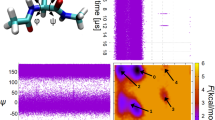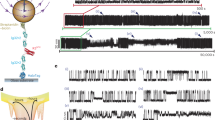Abstract
Recent advances in non-equilibrium statistical mechanics and single-molecule technologies have made it possible to use irreversible work measurements to extract free-energy differences associated with the mechanical (un)folding of molecules. To date, free-energy recovery has been focused on native (or equilibrium) molecular states, but free-energy measurements of kinetic states have remained unexplored. Kinetic states are metastable, finite-lifetime states that are generated dynamically, and play important roles in diverse physical processes. In biophysics, there are many examples in which these states determine the fate of molecular reactions, including protein binding, enzymatic reactions, as well as the formation of transient intermediate states during molecular-folding processes. Here we demonstrate that it is possible to obtain free energies of kinetic states by applying extended fluctuation relations, using optical tweezers to mechanically unfold and refold deoxyribonucleic acid (DNA) structures exhibiting intermediate and misfolded kinetic states.
This is a preview of subscription content, access via your institution
Access options
Subscribe to this journal
Receive 12 print issues and online access
$209.00 per year
only $17.42 per issue
Buy this article
- Purchase on Springer Link
- Instant access to full article PDF
Prices may be subject to local taxes which are calculated during checkout





Similar content being viewed by others
References
Dobson, C. M. Protein folding and misfolding. Nature 426, 884–890 (2003).
Jarzynski, C. Nonequilibrium equality for free energy differences. Phys. Rev. Lett. 78, 2690–2693 (1997).
Crooks, G. E. Path-ensemble averages in systems driven far from equilibrium. Phys. Rev. E 61, 2361–2366 (2000).
Ritort, F. Nonequilibrium fluctuations in small systems: From physics to biology. Adv. Chem. Phys. 137, 31–123 (2008).
Woodside, M. T., García-García, C. & Block, S. M. Folding and unfolding single RNA molecules under tension. Curr. Opin. Chem. Biol. 12, 640–646 (2008).
Jarzynski, C. Equalities and inequalities: Irreversibility and the second law of thermodynamics at the nanoscale. Annu. Rev. Condens. Matter Phys. 2, 329–351 (2011).
Collin, D. et al. Verification of the Crooks fluctuation theorem and recovery of RNA folding free energies. Nature 437, 231–234 (2005).
Shank, E. A., Cecconi, C., Jesse, W. D., Marqusee, S. & Bustamante, C. The folding cooperativity of a protein is controlled by its chain topology. Nature 465, 637–641 (2010).
Hayashi, K., Ueno, H., Iino, R. & Noji, H. Fluctuation theorem applied to F1-ATPase. Phys. Rev. Lett. 104, 218103 (2010).
Toyabe, S., Sagawa, T., Ueda, M., Muneyuki, E. & Sano, M. Experimental demonstration of information-to-energy conversion and validation of the generalized Jarzynski equality. Nature Phys. 6, 988–992 (2010).
Hummer, G. & Szabo, A. Free energy reconstruction from nonequilibrium single-molecule pulling experiments. Proc. Natl Acad. Sci. USA 98, 3658–3661 (2001).
Gupta, A. N. et al. Experimental validation of free-energy-landscape reconstruction from non-equilibrium single-molecule force spectroscopy measurements. Nature Phys. 7, 631–634 (2011).
Maragakis, P., Spichty, M. & Karplus, M. A differential fluctuation theorem. J. Phys. Chem. B 112, 6168–6174 (2008).
Junier, I., Mossa, A., Manosas, M. & Ritort, F. Recovery of free energy branches in single molecule experiments. Phys. Rev. Lett. 102, 070602 (2009).
Palmer, R. G. Broken ergodicity. Adv. Phys. 31, 660–735 (1982).
SantaLucia, J. Jr A unified view of polymer, dumbbell, and oligonucleotide DNA nearest-neighbor thermodynamics. Proc. Natl Acad. Sci. USA 95, 1460–1465 (1998).
Zuker, M. Mfold web server for nucleic acid folding and hybridization prediction. Nucleic Acids Res. 31, 3406–3415 (2003).
Huguet, J. M. et al. Single-molecule derivation of salt dependent base-pair free energies in DNA. Proc. Natl Acad. Sci. USA 107, 15431–15436 (2010).
Forns, N. et al. Improving signal/noise resolution in single-molecule experiments using molecular constructs with short handles. Biophys. J. 100, 1765–1774 (2011).
Mossa, A., De Lorenzo, S., Huguet, J. M. & Ritort, F. Measurement of work in single molecule experiments. J. Chem. Phys. 130, 234116 (2009).
Bennett, C. H. Efficient estimation of free energy differences from Monte Carlo data. J. Comput. Phys. 22, 245–268 (1976).
Shirts, M. R., Bair, E., Hooker, G. & Pande, V. S. Equilibrium free energies from nonequilibrium measurements using maximum likelihood methods. Phys. Rev. Lett. 91, 140601 (2003).
Engel, S., Alemany, A., Forns, N., Maas, P. & Ritort, F. Folding and unfolding of a triple-branch DNA molecule with four conformational states. Phil. Mag. 91, 2041–2065 (2011).
Palassini, M. & Ritort, F. Improving free-energy estimates from unidirectional work measurements: Theory and Experiment. Phys. Rev. Lett. 107, 060601 (2011).
Li, P. T. X., Bustamante, C. & Tinoco, I. Jr Real-time control of the energy landscape by force directs the folding of RNA molecules. Proc. Natl Acad. Sci. USA 104, 7039–44 (2007).
Mossa, A., Manosas, M., Forns, N., Huguet, J. M. & Ritort, F. Dynamic force spectroscopy of DNA hairpins: I. Force kinetics and free energy landscapes. J. Stat. Mech. Theor. Exp. P02060 (2009).
Acknowledgements
A.A. is supported by grant AP2007-00995 (Spanish Research Council). A.M. acknowledges funding from Lundbeckfonden. I.J. is supported by a Novartis grant (CRG). F.R. is supported by grants FIS2010-19342, Icrea Academia 2008, and Human Frontier Science Program (RGP55-2008). We thank J. Horowitz and M. Palassini for a careful reading of the manuscript.
Author information
Authors and Affiliations
Contributions
I.J. and F.R. designed the experiment. A.A. made the measurements. A.A. and A.M. analysed the data. All authors wrote the paper.
Corresponding author
Ethics declarations
Competing interests
The authors declare no competing financial interests.
Supplementary information
Supplementary Information
Supplementary Information (PDF 1434 kb)
Supplementary Information
Supplementary Information (SWF 2007 kb)
Supplementary Information
Supplementary Information (SWF 887 kb)
Supplementary Information
Supplementary Information (SWF 1366 kb)
Supplementary Information
Supplementary Information (SWF 1942 kb)
Rights and permissions
About this article
Cite this article
Alemany, A., Mossa, A., Junier, I. et al. Experimental free-energy measurements of kinetic molecular states using fluctuation theorems. Nature Phys 8, 688–694 (2012). https://doi.org/10.1038/nphys2375
Received:
Accepted:
Published:
Issue Date:
DOI: https://doi.org/10.1038/nphys2375
This article is cited by
-
Extractable quantum work from a two-mode Gaussian state in a noisy channel
Scientific Reports (2021)
-
Structural dynamics of single SARS-CoV-2 pseudoknot molecules reveal topologically distinct conformers
Nature Communications (2021)
-
Strongly coupled plasmas obey the fluctuation theorem for entropy production
Nature Physics (2018)
-
Equilibrium free energies from non-equilibrium trajectories with relaxation fluctuation spectroscopy
Nature Physics (2018)
-
Application of the fluctuation theorem to motor proteins: from F1-ATPase to axonal cargo transport by kinesin and dynein
Biophysical Reviews (2018)



